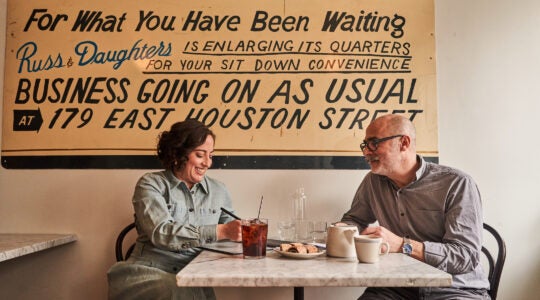As the son of a 94-year-old resident of Jewish Home Lifecare’s Manhattan facility, Bob Wilkis supports the agency’s proposal to move its home from West 106th Street to a new, high-rise tower it hopes to build nine blocks south, on West 97th Street.
“I didn’t have to be sold [on the idea] that a new building is needed,” said Wilkis, whose mother, Rhoda, has lived at JHL’s current home for more than a decade. The current home, parts of which date back to the 1880s, “is just broken,” he added, echoing the agency’s assertion that it’s outmoded, inefficient and costly. “Their engineers are always in the panic mode.”
In contrast, the new building envisioned by JHL — which with additional campuses in the Bronx and Westchester is the largest nonprofit provider of “senior-living programs” in New York State — would be a state-of-the-art facility. The new facility will be developed in conjunction with the Green House Project, a national effort to de-institutionalize nursing homes and make them more homelike.
But JHL’s proposal has divided residents of the Upper West Side, some of whom are opposing or at least questioning the project for a host of reasons, including concerns over how it might affect traffic and congestion in the neighborhood, noise levels and even the safety of schoolchildren.
Earlier this month, many of them attended a packed meeting of Manhattan’s Community Board 7, which passed a resolution that could trigger a lengthy, costly and multilayered review process. Whether it does depends on the judgment of the City Planning Commission — JHL may choose to abandon the project, said Ethan Geto, a spokesman for the agency. More seriously, he added, if no other solution emerges, the agency’s 106th Street campus — which has 514 beds, 400 for long-term patients and 114 for those in need of rehabilitation — may prove unsustainable, forcing the agency’s departure from Manhattan.
In the months leading up to the Feb. 7 meeting, JHL — better known to some New Yorkers as the Jewish Home and Hospital, its former name — argued that city law allows the agency to build the 97th Street project “as of right” as long as it meets all zoning regulations. But the rules allowing the project stipulate that three conditions have to exist before it proceeds, one of which is that there’s no scarcity of land within the district for community facilities.
The Community Board’s resolution, approved 37 to zero, with five abstentions, states that the district does, in fact, have a “scarcity of land” for “general community purposes” — a controversial finding that now goes to the City Planning Commission for review.
A rejection of that finding would allow JHL’s project to go forward, Geto explained. But if the commission agrees with the resolution, it would set in motion a “full-blown” review process requiring JHL to seek a special permit, prepare an environmental impact statement and possibly change the project’s design. The entire process could last years, requiring input from the commission, the borough president, Community Board 7 and the City Council.
Mark Diller, chair of the Community Board, believes he and his colleagues dealt with the issue fairly, allowing “everyone who wanted to be heard” a chance to be heard. Several issues need to be explored, but haven’t, Diller said, prompting the board’s action. He added that a land-use review process ensures that “folks can identify issues, explore them, find out what, if anything, can be done about them and then decide … how to proceed.”
But Sheldon Fine, one of the five Community Board members who abstained from the vote, told The Jewish Week that the board’s resolution was a “tool” to force a review process rather than a finding backed by any substantial evidence.
“I believe that City Planning is intelligent enough to understand what transpired” at last week’s meeting, said Fine, who heads the West Side Federation for Senior and Supportive Housing, a nonprofit provider of affordable housing for senior citizens. “Normally, a board resolution that shows a finding explains how it determined that finding.” But “in this resolution,” he said, “there’s no justification for the finding — just [a statement] that it was found.”
JHL agrees with Fine’s view, according to Geto.
“The reality is that Community Board 7 is not terribly concerned with the ‘scarcity of land’ issue,” he said, “but some on the board are leveraging that issue as a surrogate for the real motive” driving their opposition — namely, concern over a new building blocking their views, density, traffic and other neighborhood issues.
Geto also disputes the board’s finding, saying that no social service agency these days has the money to purchase a prime piece of Manhattan real estate and build on it. In addition, he said, JHL would actually reduce its “footprint” once it builds on 97th Street, a site occupying much less land than its current home on 106th Street. The proposed site will have fewer beds — 414, compared to the current site’s 514 — and was obtained through a land swap negotiated with a major developer.
Whatever the justification for the “scarcity of land” finding, no one denies that the neighborhood around JHL’s new site, now a parking lot for 20 cars, is plagued with a good many problems, including gridlock along 97th Street, a designated truck route.
“We already have a situation at certain points of the day where emergency vehicles can’t get through,” said Hillel Hoffman, vice president of West Siders for Public Participation. Like many of those opposing the project, Hoffman lives in Park West Village, a complex of buildings surrounding the site, and belongs to a tenants group that has taken a strong stand on the issue.
Some people have accused the project’s opponents of NIMBY, Hoffman said, referring to the acronym for “not in my backyard.” But “my response is that we’re way beyond NIMBY. We’ve just gone through five years of construction on five new apartment buildings and wall-to-wall retail establishments on both sides of Columbus Avenue from 97th Street to 100th Street.”
Other concerns involve the students attending P.S. 163, the elementary school next to the site, and how the project could pose risks to their safety and their quality of education, said Carrie Reynolds, co-president of the PTA.
Officials at JHL, an agency of UJA-Federation of New York, have worked closely with members of the community to address their concerns, Geto said. The height of the proposed building has been reduced from 24 stories to 20; the design now includes an access road; the agency would establish a 24-hour hotline for neighbors to call with concerns; and construction would be limited to minimize any adverse impact on the students of P.S.163.
♦
Meanwhile, those supporting the project are expressing concern over the impact on the area’s elderly should the building not proceed and the 106th Street campus close.
The loss of JHL “would be terrible not only for people who want to remain in the community and need the agency’s services, but also for the families of the elderly who want to be close to their relatives,” Fine said. He and others note that JHL, which also has campuses in the Bronx and Westchester, serves a population of mostly frail and indigent patients, including many blacks and Latinos.
Fine said it would be “tragic” if JHL disappeared from Manhattan, pointing out that it’s the only large health provider for the elderly in Community District 7, which runs from 59th to 110th streets. Recalling a personal story, he said one man from his shul, Young Israel of the West Side, needed long-term nursing care several years ago and initially found it at St. Barnabas Hospital in the Bronx, where it was “very hard” for other congregants to visit him. He was eventually moved to the Jewish Home, where, for the remaining four years of his life, he received frequent visits from his Young Israel friends.
The void would be especially great considering how many nursing homes have disappeared in recent years. Bob Kramer, president and CEO of the National Investment Center for the Seniors Housing and Care Industry, an organization that tracks trends in the field for lenders, investors and developers, said he’s counted an average of 30 closures each year in the 31 largest urban areas since 2007. In the New York area, he added, the figure has been two closures a year during the same period.
For Bob Wilkis, of course, the loss would be personal.
President of Relatives and Friends of Manhattan Jewish Home, Wilkis brought his mother to the city in 2001 only to watch as her health declined, prompting her hospitalization and, later, her move to JHL. Rarely a day goes by when he doesn’t visit his mother, said Wilkis, who lives within blocks of the home on the Upper West Side.
But Wilkis said he’d find it difficult to continue that schedule should his mother have to move to a nursing home outside Manhattan. He understands the concerns of his Upper West Side neighbors, he said, but “no one is going to profit” from JHL’s move to 97th Street.
“I just believe from the bottom of my heart that the good outweighs the bad,” he said.
The New York Jewish Week brings you the stories behind the headlines, keeping you connected to Jewish life in New York. Help sustain the reporting you trust by donating today.




